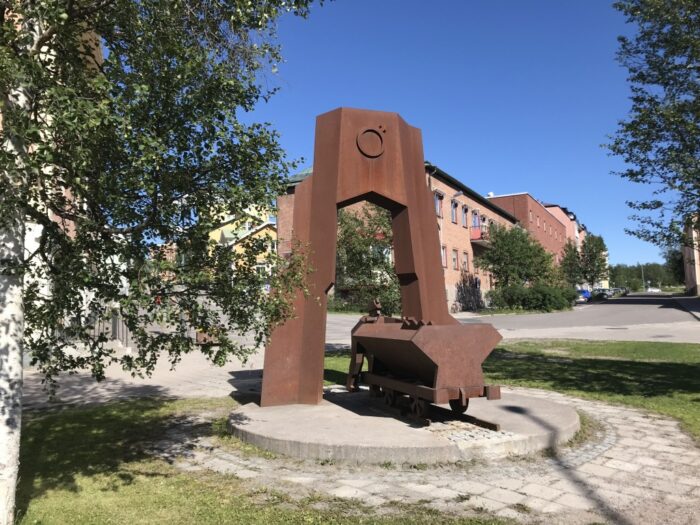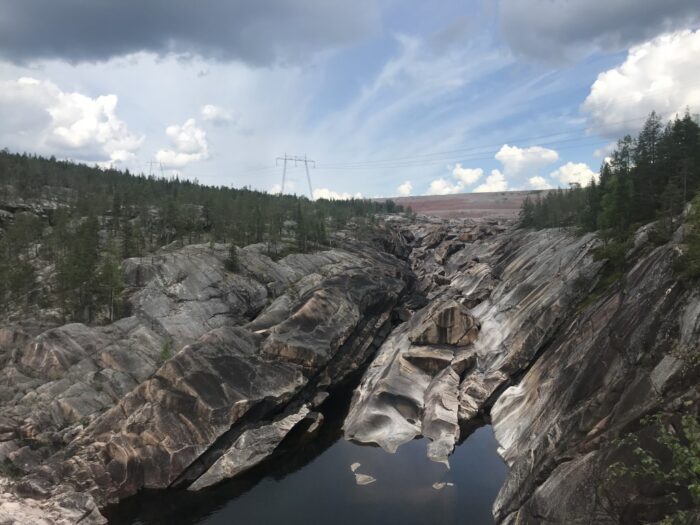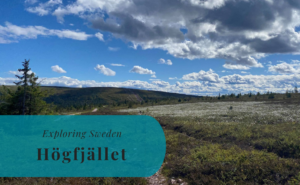My paternity leave is still continuing and the summer saw several trips. One of the more recent is a trip to the far north of Sweden. This time actually without Susann. Instead, Little A and I boarded a flight to Kiruna and joined my parents for the weekend. My parents had driven from south of Stockholm all the way up to Gällivare in Swedish Lapland. This was also the first time I flew alone with Little A.
Swedish Lapland
Swedish Lapland is a vast area compromising almost a quarter of the total land area of Sweden. For centuries, Lapland was actually not a part of Sweden. Its population was mostly made up of nomadic Sami people. The colonization took place from the middle ages onwards with settlers from southern Sweden and Swedish-controlled Finland. Luckily cultural assimilation has not been completed. There is still a lot of Sami culture in the region and you might catch a glimpse of herds of reindeer walking along the roads.
Swedish Lapland should not be confused with Finnish Lapland. Until 1809, the two regions were one and the same. It was when Sweden lost its eastern part to Russia in the Finnish War of 1808-1809 that this region was split as well.
A big part of the region is located north of the arctic circle. Here you find towns that have mostly grown around the mining industry, hydroelectric plants or forestry. The two largest towns are Kiruna and Gällivare, both of which are important for the Swedish mining industry.
Little A at Arlanda Airport
Swedish airports really are some of the worst in the world when traveling with small children. Arlanda can be a nightmare when traveling alone with a toddler. Leaving Little A’s pushchair at the check-in and getting to borrow one from the airport was luckily easy this time. We have had problems in the past with all of them already taken, Getting through security is a challenge everywhere with a toddler, luckily most people are understanding why it takes some extra time when emptying your bag of the computer, the liquids, and the food for the little one. It does, indeed, take quite a lot of extra time even when well prepared.
After security at terminal 4 Little A had to wait for me to eat some lunch. Then it was full-speed playing in the playroom. She really enjoyed playing with all the other kids, probably more than they did. Even the older kids backed away when she ran around screaming with joy. It was probably not the play area itself that was interesting, but more the other kids.
Our flight did, however, get delayed by half an hour. My well-planned timing of her midday rest was suddenly out of sync. Instead, I had to keep her awake for another 30 minutes and she was not happy once we finally boarded the plane. A small snack to keep her happy for a few more minutes and she fell asleep as soon as the engines were started. She actually slept most of the 90 minutes flight and woke up first during our descent. We were about to arrive in Swedish Lapland.


Arriving in Kiruna
Kiruna Airport is small, very small. It is located just a few kilometers outside of Kiruna and there is mostly forest around it. Here we arrived and Little A soon sat in her stroller. Which was something she did not enjoy at all. She wanted to walk by herself instead. So, we had a little disagreement in regards to how to proceed. As usual, it took some time to convince her that it wasn’t her decision to make. We walked to Kiruna, as the sun was shining and we needed some fresh air after the hours of traveling.
Kiruna is the first of the two towns we visited during this trip. It is in the process of being moved. It is the iron mine that is forcing the town to relocate most of its central parts to a new location a few kilometers away. During the walk, we passed the new town hall as well as the big construction site that is the new center. It is quite impressive to see the amount of work needed to relocate a town of Kiruna’s size. Considering that the town is only partly being moved and that not all of its 17.000 inhabitants are directly affected, the work is still immense.
The center is quite small, but at the same time, we are in the northernmost town of Sweden. There might not be many great sights in the town itself, the only exception might be the church – which is one of Sweden’s largest wooden buildings. From the hill where the center of Kiruna is currently located there is, however, an interesting view out over the surrounding landscape. LKAB’s iron mine just next to lake Luossajärvi offers some big contrasts. It is also possible to see the mountains in the distance in the direction of the border with Norway,
We did not spend much more than an hour in the center before continuing towards the train station. I knew that they had moved it to a temporary location due to the relocation, I did however not know if they had updated all the signs. Asking a local for direction was intriguing. Being located only two kilometers from the center, I was planning to walk there. The locals were probably thinking that I was crazy to do that in the heat – it was around 30 degrees Celcius during our visit. Compared to Stockholm and our recent trip to Athens and Rome, this was quite ok. But I guess that the locals were less used to it and were satisfied enough to point to me that it was quite hot today. The directions were easy to follow and it was a nice walk through old workers’ neighborhoods to the station. We were soon on the train taking us an hour south – to Gällivare.






Staying in Gällivare with the Midnight Sun
In Gällivare Little A and I met up with my parents who were on a road trip up north visiting a relative. We were staying four nights in a cabin at Gällivare camping. There are many similarities between Kiruna and Gällivare. The biggest similarity is probably the iron mines. Once more, you probably would not visit Gällivare to enjoy the town itself. As with most of the north in Sweden – it is the nature that you want to see.
Luckily nature is not far away while in Gällivare. We had the river Vassaraälven just next to the camping and we could see the mountain and nature preserve Dundret overlooking the area. There are, however, long distances between places of interest in this part of Sweden. Estimating driving times is also quite hard, you never know how many raindeers will block the road.
The midnight sun was also a new experience. Taking a walk at midnight with the sun shining, going to bed with the sun still shining, and waking up without noticing much of a difference compared to the evening before. Well, the sun did go down a little below the horizon, but it was not enough to cause any bigger darkness – making it quite hard to keep our daily routines.





Visiting Dundret and Malmberget
We spent our first full day in Gällivare exploring two areas in the vicinity. First, we drove up to the top of the mountain Dundret which overlooks Gällivare. The peak is at 823 meters above the sea and due to the flat landscape around it, it is possible to see very far into the distance. The whole mountain is marked as a nature reserve and some of the few constructions include the road and the ski slopes.
We only took a short, but slow, walk at the top, making sure to enjoy the view and take a few photos. Little A was quite unhappy as she wasn’t allowed to run around and explore by herself. Being stuck in a baby carrier is probably not fun when there is such a big area to run around in.
From Dundret we continued to Malmberget. Malmberget is the second town that is being moved to make room for the iron mines. Well, when it comes to Malmberget it seems to be mostly due to safety reasons as the mine has already passed the line where the town needs to be moved. Like in Kiruna, new residential areas are being built and important buildings are being moved. This time most parts are being moved to Gällivare.
Driving through Malmberget felt like driving through a ghost town. There are so many empty buildings and closed stores and barely anyone out on the streets. Our stop in the town was the old part named “Kåkstaden”. Kåkstaden has its roots in the late 19th-century mining in the area. It is a township where the workers built their own homes due to the lack of accommodation. It was later torn down but rebuilt in 1988 when Malmberget celebrated 100 years. Kåkstaden has a few old-fashioned shops as well as a cafe. It is a really cozy place for a walk. Sadly this is a place that might once more be torn down when Malmberget is being moved.
From Malmberget we continued to my relative’s home in a residential area not too far from the center for a cup of coffee. This area was even more abandoned and most houses already stood empty. It will for sure be a ghost town in the near future.








Day Trip to Jokkmokk
On the second day, we decided to take a short day trip to Jokkmokk, which is about an hour away. Along the route, there are several large hydroelectric power plants that I wanted to see. So we started to drive south and soon got stuck in a large road reconstruction. The asphalt had been removed and we had to enjoy the gravel. Instead of an hour of driving, it took us nearly two to reach Jokkmokk. On our way, we stopped first in Porjus, which is a town built around its power plant. The town has one of the oldest hydroelectric power plants in Sweden. The Porjus Hydroelectric Power Station was built already in 1910-1915.
Just a few minutes after Porjus we made our second stop. This time at Harsprånget hydroelectric power station. Both of the plants are located on the Lule River. With Porjus being one of the oldest, Harsprånget is the largest hydroelectric power station in Sweden with an effect of 977 MW. We were not able to get close to the giant dam, but seeing the deep and almost empty groove after the plant was impressive.
We finally also reached Jokkmokk and my mother’s biggest disappointment was that she still hadn’t seen any reindeer. Somehow we had managed to miss the most famous inhabitants of Swedish Lapland. Jokkmokk is mostly famous for its the Jokkmokk market in February each year. It attracts thousands of people and is an important event for the Sámi people. The temperature is, however, really low at that time of the year.
During our visit, in the middle of the summer, there was less activity in the town. We enjoyed a short lunch and a walk before heading back to Gällivare. This time by another road – which probably took equally long to drive but did not mean driving at 30 km/h. However, we were able to see quite a lot of reindeer along the road.





A Relaxing Day in Gällivare
Our last day in Gällivare was a day to relax. We took a walk along one of the lakes, said hello to all the mosquitos, and just relaxed. Little A got to try to swim in the river but didn’t like the chilly water. Hopefully, there will be more visits to Swedish Lapland. Perhaps I will be able to convince Susann to come along too. It really feels like there is a lot more to explore.


Heading Back Home from Swedish Lapland
Eventually, Little A and I were back on the train towards Kiruna. This time we took the free shuttle bus from the train station to the center. After a quick lunch and a short walk around the center, we were soon on the bus back to the airport.
Once at the airport it was a bit chaotic. The two flights before ours had problems with check-in and got quite delayed. Luckily Little A and I had two hours left before our flight and could sit and relax for some time. Little A was, however, a lot happier once we had checked in and passed security. She could then, once more, play around before our flight. Once it was time to board she was finally so tired that she fell asleep in my arms. Traveling alone with a sleeping child turned out to be a challenge. Carrying her to the plane and being seated was not so easy. Luckily, I was able to do it without hitting her head on the chairs in front of ours.
Read More About Swedish Lapland
Here are the places that we visited:
- Kiruna, Lappland – Exploring Sweden
- Gällivare, Lappland – Exploring Sweden
- Malmberget, Lappland – Exploring Sweden
- Porjus, Lappland – Exploring Sweden
- Jokkmokk, Lappland – Exploring Sweden
More about Lappland and Sweden:






